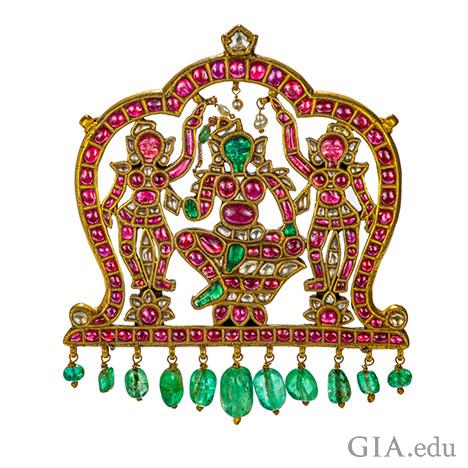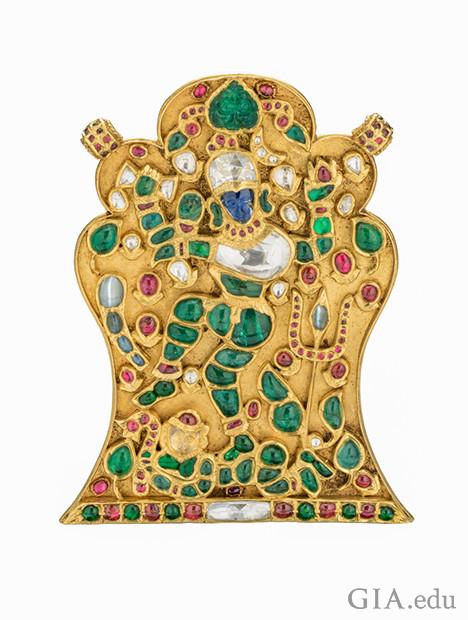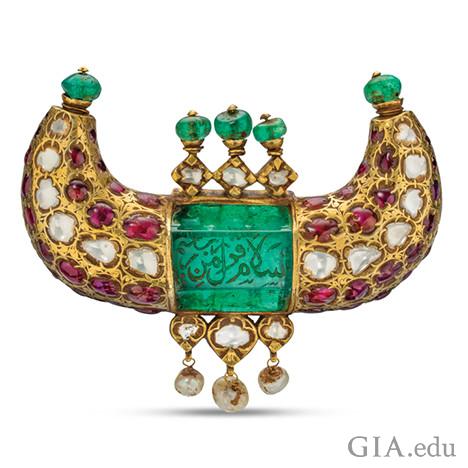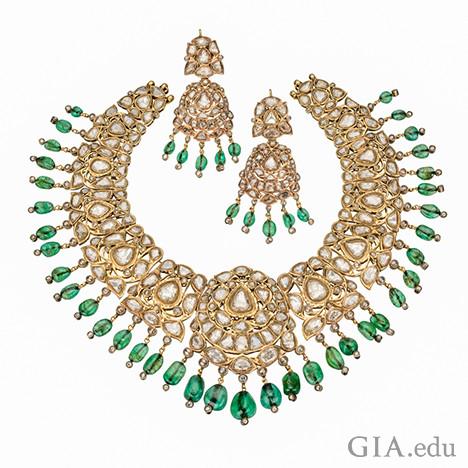Large flawless diamonds from the Golconda region. Rich green emeralds from Colombia. Blood-red rubies from Burma. Only the most visually striking would do, set in only in the purest gold. For more than 5,000 years, jewelry has played an integral role in the history of India. Wars were fought and empires won and lost in pursuit of these riches. Yet, because of cultural practices, relatively little of the historic jewelry exists, the gems and precious metals repurposed by succeeding generations.
The jewels in “Centuries of Opulance: Jewels of India,” are on display in Carlsbad, GIA campus, and are on loan from a private collection until March, 2018. This is over 300 years of adornment from the 17th through the 20th century.
In fact, it was a thirst for the fabled riches of Northern India that drew Babur, the Muslim founder of the Mughal Empire, from Central Asia. Lavishly adorned with the jewels they had won, received as “gifts” or created from the vast stores of gems and gold in their treasuries, the Mughals and other rulers of India continued to honor the religious, metaphysical and social importance of the precious materials and the forms they took.
Intricately designed pieces celebrated Allah and Hindu gods, such as Shiva, Krishna and Vishnu. Other jewels were integral to the marriage contract, as seen in the elaborate wedding necklaces, in depictions of snakes or fish as symbols of fertility, and in nose rings worn as testament to happiness in the union. Brightly colored gems and enamel symbolized the forces of life: red as blood, the life force of the animal kingdom; green as the plant life created by the blue sky combined with the yellow sun. To this day in India, gems and jewelry carry potent messages of power, honor and love.
Adventurers traveled long distances to get the best of gems they could find. What is not known is that at one time India was the primary source for magnificent diamonds, including the famed Hope Diamond on display at the Smithsonian in Washington D.C.The Indian aristocracy kept the best for themselves and traded the balance for emeralds, rubies, sapphires, spinels and pearls from all corners of the earth.
Quality was paramount. Only the finest gems and purest gold would evoke maximum power to honor the gods and serve as talismans to ward off evil. Gemologists were valued members of most royal courts in India. The Mughal Emperor Aurangzeb (reign 1658–1707) had three in his entourage: one to care for the gems, a second to estimate their value, and the third to grade them and detect treated gems or imitations. Gemological knowledge was passed from father to son for generations, but also taught in texts such as the notorious Kama Sutra.
“The treasury has its source in the mines; from the treasury the Army comes into being, with the Treasury and the Army, the Earth is obtained…..” So wrote Indian statesman Kautilya in his 4th century Arthashastra, a how-to guide for managing an empire. Since antiquity, the most important mines were diamonds. And the most ancient of India’s three main diamond-producing areas were near the legendary fortress city of Golconda. The exact locations were a closely guarded secret that promised a horrible death for any who revealed it. Golconda was the center for trade in diamonds, launching caravans as large as 10,000 camels and oxen to travel across Asia
According to the Indian life science Ayurveda, wearing a diamond will guarantee long life, endurance and beauty. The thin, flat diamonds seen in historical Indian jewelry are typically slices cleaved from the original rough, many with flat facets polished around their edges. Not until the 19th century did brilliant cut diamonds begin to appear in India, as finished stones and faceting techniques arrived from Europe.
Many spectacular diamonds originated from Indian mines. These include the legendary 105 carat Koh-i-Noor Diamond, now in the British Crown Jewels, and the ill-fated 45 carat blue Hope Diamond, which brought misery to many before Harry Winston donated it to the Smithsonian Institution in 1958. Much of what has been written about the tragedies that fell upon the owners of the Hope Diamond, have been exaggerated at best. It makes for great reading though.
Today, the Golconda mining region is largely exhausted. It is estimated that the Indian mines produced at least 12 million carats over more than 2,000 years. Yet even as these mines waned, the discovery of diamonds in Brazil in the early 1700s and then South Africa in the late 1860s brought a continued supply to India’s royal connoisseurs.

I have had many customers from India, and the young women still receive for wedding presents, 22kt gold embedded with some of the most beautiful diamonds, rubies, sapphires, and emeralds I have seen in a long time. All the stones are near flawless and are in necklaces and rings primarily. The bracelets are usually very solid and 22kt bangles. Two can easily weight 45 grams. There are 31.1 grams in a troy ounce. These gifts are required by family members and friends and if you do not come forth with the goods, that will not bode well for you.
These young women come in here to sell their bounty. I asked them why, the first one I saw was exquisite, and could not help myself, I said why would you even consider selling this. Her answer was very simple, my husband and I would rather have cash and where would I wear this? OK, she had a point but me being so adoring of gemstones did not think any further than that. This necklace was closer to a bib. Intricate 22 kt gold and the most gorgeous of gemstones. Almost nine times out of ten, the items brought in were diamonds, rubies, emeralds, and blue sapphire.What they usually keep are the bangles unless they were given a dozen or so. Now these are young women, the older generation do not come in here to sell, ever.
One young couple brought their items in and asked me if I could weigh them, I said yes, and what they were doing was getting a weight on all the gold in the items, putting a dollar price based on the gold and 2.3 percent is to be given as charitable donation, I was told. Based on the weight of all these it would appear someone is going to be on the receiving end of a hefty donation. They have made three trips in here. Now understand my job is to buy it, not weigh it but I do it as a courtesy because one day they will sell off some of it.
I am first to admit some of the most beautiful items have been from India. Rings, bracelets, chains, didn’t matter. The workmanship is impeccable. Each piece is a work of art, and to be admired.
Courtesy GIA
